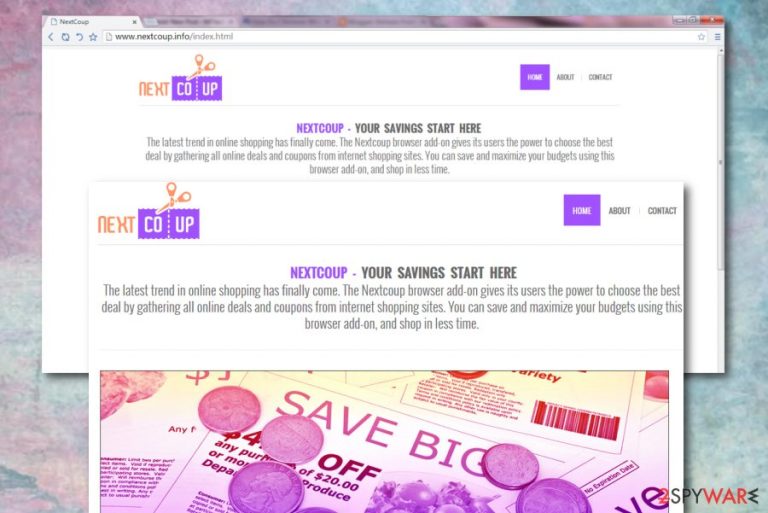NextCoup ads (Removal Guide) - Jan 2020 update
NextCoup ads Removal Guide
What is NextCoup ads?
NextCoup is a PUP that promotes itself as a helpful browser add-on that provides all types of handy offers from the web

NextCoup is described as a browser add-on[1] that allows gathering all types of beneficial deals from the Internet. However, note that this is only a marketing strategy used to promote the app and it truly has deserved the reputation of a potentially unwanted program as it causes continuous pop-ups, banner ads, sponsored links, and similar distractions during people's browsing.
This program can hardly pose direct harm to the computer because the main thing, which is initiated by it, is these continuous pop-up notifications. However, some indirect danger can be brought through its redirecting sessions that we are going to discuss in the following paragraphs.
| Name | NextCoup |
|---|---|
| Extension names | NextCoupp, NeXXXTCoup, NextCOiuuP |
| Type | Adware app/potentially unwanted program |
| Promotion | This suspicious app promotes itself as a helpful browser add-on that is capable of delivering the most relevant deals and helping users to maximize their budgets |
| Appearance | The adware can show up on both Windows and Mac computer systems. Also, it is likely to infect any type of web browsers such as Google Chrome, Mozilla Firefox, Internet Explorer, Microsoft Edge, and Safari |
| Activities | Once the PUP appears on the computer system, it can initiate intrusive advertising activities, redirect the user to affiliate domains, collect non-personal information that is related to the user's browsing experience |
| Elimination | You can get rid of the adware program with the help of automatical software or the manual step-by-step instructions that we have appended to the end of this article |
| Fix tip | If you have discovered some altered areas on your computer, you can try repairing them with FortectIntego |
NextCoup can appear anywhere on the computer system and install additional objects in directories such as C:\Program Files\ or C:\ProgramData (if you are a Windows user). Additionally, the adware can initiate significant changes on web browsers and their homepage, new tab URL bars. Besides, once this browser add-on installs in your web browser settings, the extension can come in different types of names such as NextCoupp, NeXXXTCoup, or NextCOiuuP.
The advertising part of the article's culprit can be one of the most intrusive activities that will likely appear during the operation period of this adware program. It might start loading you with attractive-looking deals that offer to purchase rogue tools or services. You should decline any suggestions provided, especially those which ask you to type in some sensitive details, contact information, credential data, or urge an inadequate payment.
Nevertheless, NextCoup ads can easily turn your browsing into serious havoc because they may start appearing on each of your web browsers, including Internet Explorer, Google Chrome, Mozilla Firefox, and others. Besides, no matter how harmless they look (in most of the cases they report about discounts, coupons, price comparisons, and similar things) each of these ads has a link, which may redirect you where ever it wants.

It means that you may be tricked into entering not only a harmless shopping site. Also, you might be forced to visit an insecure site, which is used to spread more dangerous programs than this one. This is how adware gets the chance to deliver malicious applications indirectly. As a matter of fact, this is a popular distribution technique used by various cyber criminals who tend to spread virtual parasites such as Trojan horses[2] and ransomware viruses.
If you think that NextCoup virus has already infiltrated your computer, you should know that it can also start tracking your browsing on the web. In most cases, such programs collect information about people's search terms, mostly visited websites, data that they enter on each of these sites, their email address, PC's location, etc. Afterward, the developers use such information for delivering it to other parties for income or initiating beneficial advertising campaigns.
So, as you can clearly see, you should remove NextCoup from your computer without wasting your time. Otherwise, it will keep initiating these previously mentioned activities and you will not be able to use your web browser properly anymore due to all these changes. If you want to do that ASAP, you should check the system with reliable anti-spyware like Malwarebytes or SpyHunter 5Combo Cleaner. Also, if there are some altered entries and other areas on your system, try fixing them with a repair tool such as FortectIntego.

In some cases, the removal might not be necessary. This is if your antivirus program does not find anything suspicious on your computer and if the activities from the app show up on your browser only occasionally. Sometimes, you might start seeing annoying advertisements while visiting third-party apps but that does not always mean that you are infected with adware. Try downloading AdBlock and see if it stops the incoming notifications.
However, if NextCoup activities get very intrusive, you should not postpone the removal process, otherwise, your web browser and computer system might become very sluggish and not be able to carry out simple actions. Also, if you ever deal with this adware, try not to fall for its attractive-looking descriptions like the following one:
The latest trend in online shopping has finally come. The Nextcoup browser add on gives its users the power to choose the best deal by gathering all online deals and coupons from internet shopping sites. You can save and maximize your budgets using this browser add on, and shop in less time.
“Software bundling” is not the only tactic employed for adware distribution
Some potentially unwanted programs can be installed either voluntarily or not. PUPs such as adware are sometimes promoted as “useful” extensions on their official websites and try to encourage people to install them. However, you should not opt for such an installation, as you will likely end up with a useless product on your computer.
However, the most common way to receive an adware program is through “software bundling”. This happens when you get the PUP installed in a freeware[3] or shareware package. Adware approaches those users who do not pay enough attention to the downloading process or have set the “Quick” installation mode as default.
In order to keep yourself safe from adware and similar threats, you should never skip any downloading or installing steps as some of them might recommend adding the PUP to your machine. Additionally, always make sure to choose the “Custom” installation mode and check out all suspicious products during the downloading process.
Besides “software bundling”, there are other deceptive tactics that can be used by adware developers to distribute their suspicious products. For example, they might plant the PUP into an unsecured advert or hyperlink. Nevertheless, the adware can come disguised as a fake flash player update while visiting third-party networks.
Removing NextCoup virus from PCs
This virus will definitely show itself by displaying intrusive pop-ups on your computer screen and redirecting you to odd domains. If you encounter these activities on your web browser and machine, note that there is an adware that requires a full elimination process, otherwise, you will still get lured in its intrusive tasks.
NextCoup removal is a process that can be performed with the help of automatical antimalware software or manual step-by-step guidelines that we have provided to you at the end of this article. Security experts from LesVirus.fr[4] claim that using reliable products is the safest and most effective way to terminate the adware and all its added components.
However, if the fact of purchasing an antimalware program does not seem attractive to you, you can always try to remove NextCoup manually. Just keep in mind that this process requires cleaning both the operating system and infected web browser apps.
You may remove virus damage with a help of FortectIntego. SpyHunter 5Combo Cleaner and Malwarebytes are recommended to detect potentially unwanted programs and viruses with all their files and registry entries that are related to them.
Getting rid of NextCoup ads. Follow these steps
Uninstall from Windows
To clean your Windows computer system from annoying apps and erase all the additional products that were brought by the adware program, apply the following instructing guidelines.
Instructions for Windows 10/8 machines:
- Enter Control Panel into Windows search box and hit Enter or click on the search result.
- Under Programs, select Uninstall a program.

- From the list, find the entry of the suspicious program.
- Right-click on the application and select Uninstall.
- If User Account Control shows up, click Yes.
- Wait till uninstallation process is complete and click OK.

If you are Windows 7/XP user, proceed with the following instructions:
- Click on Windows Start > Control Panel located on the right pane (if you are Windows XP user, click on Add/Remove Programs).
- In Control Panel, select Programs > Uninstall a program.

- Pick the unwanted application by clicking on it once.
- At the top, click Uninstall/Change.
- In the confirmation prompt, pick Yes.
- Click OK once the removal process is finished.
Delete from macOS
Remove items from Applications folder:
- From the menu bar, select Go > Applications.
- In the Applications folder, look for all related entries.
- Click on the app and drag it to Trash (or right-click and pick Move to Trash)

To fully remove an unwanted app, you need to access Application Support, LaunchAgents, and LaunchDaemons folders and delete relevant files:
- Select Go > Go to Folder.
- Enter /Library/Application Support and click Go or press Enter.
- In the Application Support folder, look for any dubious entries and then delete them.
- Now enter /Library/LaunchAgents and /Library/LaunchDaemons folders the same way and terminate all the related .plist files.

Remove from Microsoft Edge
Delete unwanted extensions from MS Edge:
- Select Menu (three horizontal dots at the top-right of the browser window) and pick Extensions.
- From the list, pick the extension and click on the Gear icon.
- Click on Uninstall at the bottom.

Clear cookies and other browser data:
- Click on the Menu (three horizontal dots at the top-right of the browser window) and select Privacy & security.
- Under Clear browsing data, pick Choose what to clear.
- Select everything (apart from passwords, although you might want to include Media licenses as well, if applicable) and click on Clear.

Restore new tab and homepage settings:
- Click the menu icon and choose Settings.
- Then find On startup section.
- Click Disable if you found any suspicious domain.
Reset MS Edge if the above steps did not work:
- Press on Ctrl + Shift + Esc to open Task Manager.
- Click on More details arrow at the bottom of the window.
- Select Details tab.
- Now scroll down and locate every entry with Microsoft Edge name in it. Right-click on each of them and select End Task to stop MS Edge from running.

If this solution failed to help you, you need to use an advanced Edge reset method. Note that you need to backup your data before proceeding.
- Find the following folder on your computer: C:\\Users\\%username%\\AppData\\Local\\Packages\\Microsoft.MicrosoftEdge_8wekyb3d8bbwe.
- Press Ctrl + A on your keyboard to select all folders.
- Right-click on them and pick Delete

- Now right-click on the Start button and pick Windows PowerShell (Admin).
- When the new window opens, copy and paste the following command, and then press Enter:
Get-AppXPackage -AllUsers -Name Microsoft.MicrosoftEdge | Foreach {Add-AppxPackage -DisableDevelopmentMode -Register “$($_.InstallLocation)\\AppXManifest.xml” -Verbose

Instructions for Chromium-based Edge
Delete extensions from MS Edge (Chromium):
- Open Edge and click select Settings > Extensions.
- Delete unwanted extensions by clicking Remove.

Clear cache and site data:
- Click on Menu and go to Settings.
- Select Privacy, search and services.
- Under Clear browsing data, pick Choose what to clear.
- Under Time range, pick All time.
- Select Clear now.

Reset Chromium-based MS Edge:
- Click on Menu and select Settings.
- On the left side, pick Reset settings.
- Select Restore settings to their default values.
- Confirm with Reset.

Remove from Mozilla Firefox (FF)
To eliminate suspicious components from Mozilla Firefox and bring the web browser back to its previous state, you should employ the below-provided step-by-step guidelines.
Remove dangerous extensions:
- Open Mozilla Firefox browser and click on the Menu (three horizontal lines at the top-right of the window).
- Select Add-ons.
- In here, select unwanted plugin and click Remove.

Reset the homepage:
- Click three horizontal lines at the top right corner to open the menu.
- Choose Options.
- Under Home options, enter your preferred site that will open every time you newly open the Mozilla Firefox.
Clear cookies and site data:
- Click Menu and pick Settings.
- Go to Privacy & Security section.
- Scroll down to locate Cookies and Site Data.
- Click on Clear Data…
- Select Cookies and Site Data, as well as Cached Web Content and press Clear.

Reset Mozilla Firefox
If clearing the browser as explained above did not help, reset Mozilla Firefox:
- Open Mozilla Firefox browser and click the Menu.
- Go to Help and then choose Troubleshooting Information.

- Under Give Firefox a tune up section, click on Refresh Firefox…
- Once the pop-up shows up, confirm the action by pressing on Refresh Firefox.

Remove from Google Chrome
To remove the adware from your Google Chrome web browser and diminish the suspicious changes that the app has initiated, follow these instructing steps.
Delete malicious extensions from Google Chrome:
- Open Google Chrome, click on the Menu (three vertical dots at the top-right corner) and select More tools > Extensions.
- In the newly opened window, you will see all the installed extensions. Uninstall all the suspicious plugins that might be related to the unwanted program by clicking Remove.

Clear cache and web data from Chrome:
- Click on Menu and pick Settings.
- Under Privacy and security, select Clear browsing data.
- Select Browsing history, Cookies and other site data, as well as Cached images and files.
- Click Clear data.

Change your homepage:
- Click menu and choose Settings.
- Look for a suspicious site in the On startup section.
- Click on Open a specific or set of pages and click on three dots to find the Remove option.
Reset Google Chrome:
If the previous methods did not help you, reset Google Chrome to eliminate all the unwanted components:
- Click on Menu and select Settings.
- In the Settings, scroll down and click Advanced.
- Scroll down and locate Reset and clean up section.
- Now click Restore settings to their original defaults.
- Confirm with Reset settings.

Delete from Safari
Remove unwanted extensions from Safari:
- Click Safari > Preferences…
- In the new window, pick Extensions.
- Select the unwanted extension and select Uninstall.

Clear cookies and other website data from Safari:
- Click Safari > Clear History…
- From the drop-down menu under Clear, pick all history.
- Confirm with Clear History.

Reset Safari if the above-mentioned steps did not help you:
- Click Safari > Preferences…
- Go to Advanced tab.
- Tick the Show Develop menu in menu bar.
- From the menu bar, click Develop, and then select Empty Caches.

After uninstalling this potentially unwanted program (PUP) and fixing each of your web browsers, we recommend you to scan your PC system with a reputable anti-spyware. This will help you to get rid of NextCoup registry traces and will also identify related parasites or possible malware infections on your computer. For that you can use our top-rated malware remover: FortectIntego, SpyHunter 5Combo Cleaner or Malwarebytes.
How to prevent from getting adware
Protect your privacy – employ a VPN
There are several ways how to make your online time more private – you can access an incognito tab. However, there is no secret that even in this mode, you are tracked for advertising purposes. There is a way to add an extra layer of protection and create a completely anonymous web browsing practice with the help of Private Internet Access VPN. This software reroutes traffic through different servers, thus leaving your IP address and geolocation in disguise. Besides, it is based on a strict no-log policy, meaning that no data will be recorded, leaked, and available for both first and third parties. The combination of a secure web browser and Private Internet Access VPN will let you browse the Internet without a feeling of being spied or targeted by criminals.
No backups? No problem. Use a data recovery tool
If you wonder how data loss can occur, you should not look any further for answers – human errors, malware attacks, hardware failures, power cuts, natural disasters, or even simple negligence. In some cases, lost files are extremely important, and many straight out panic when such an unfortunate course of events happen. Due to this, you should always ensure that you prepare proper data backups on a regular basis.
If you were caught by surprise and did not have any backups to restore your files from, not everything is lost. Data Recovery Pro is one of the leading file recovery solutions you can find on the market – it is likely to restore even lost emails or data located on an external device.
- ^ Sandra Clitter. http://www.yourtechtamer.com/blog/2017/01/what-are-browser-add-ins-add-ons-extensions-and-plug-ins-and-why-do-i-care/. Your Tech Tamer. Blog.
- ^ What is a Trojan? Is it a virus or is it malware?. Norton. Internet Security.
- ^ Freeware. Techopedia. Tech terms and definitions.
- ^ LesVirus.fr. LesVirus. Security and spyware news.
